|
Jan
02
2023
|
|
Posted 3 years 16 days ago ago by Admin
|
|
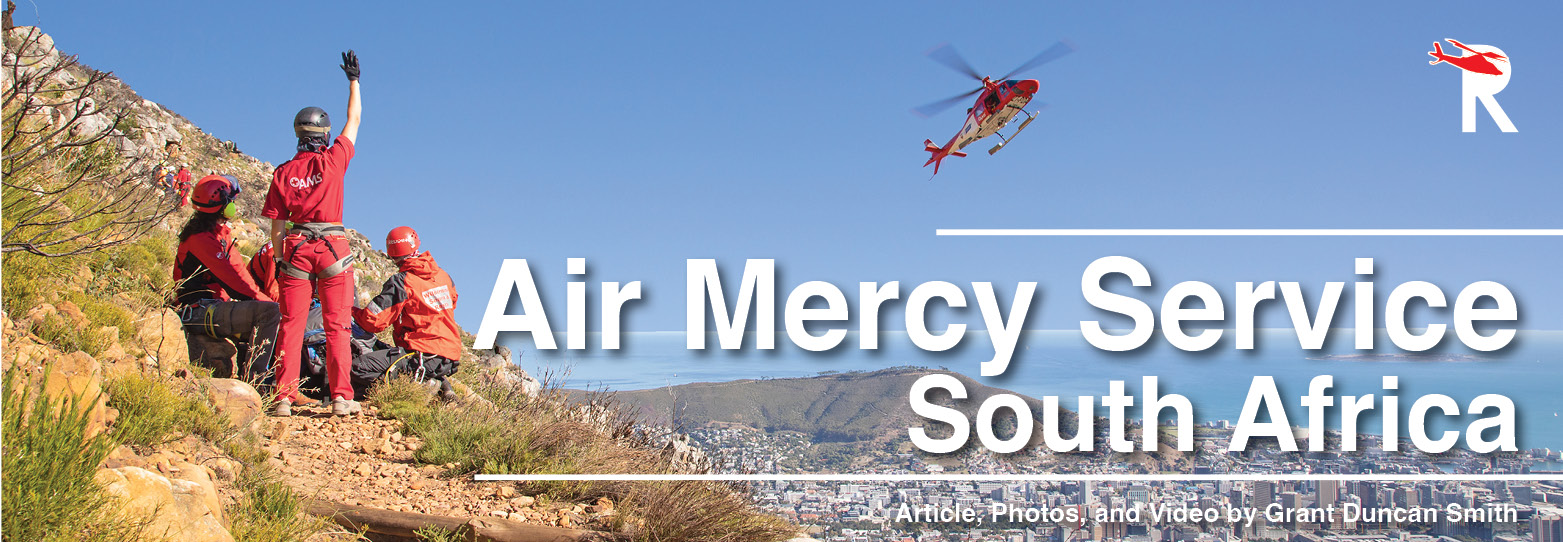
WATCH VIDEO
The South Africa Red Cross Air Mercy Service Trust (AMS) in partnership with the Emergency Medical Services of the Western Cape Government Health and Wellness provides an emergency rescue and air ambulance service to the community of the Western Cape Province via a fleet of helicopters and fixed-wing aircraft. This partnership aims to ensure that all citizens have access to equitable, acute specialized care at all levels.
The AMS’s rescue platform, which provides air-sea and air-mountain rescue services by helicopter, has more than 20 years of experience working with the Western Cape Department of Health and Wellness Wilderness Search & Rescue (WSAR), Lifesaving South Africa, and its many affiliates.
Their approach to the development of people and addressing the current shortage of skills within the specialized aero-medical field has resulted in the successful training of 24 full-time AMS paramedics as external load operators (ELO), four of whom are females, including the private sector's first female rescue ELO.
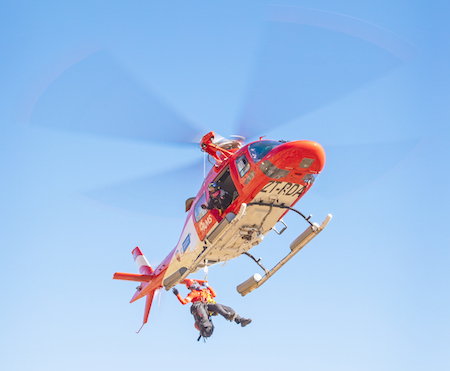
The stringent ELO training program is focussed around safety and efficiency and has been developed taking international and local best practices into account from South Africa’s air force.
The ELO is a crucial member of the helicopter rescue crew, which also consists of the command pilot, rescue-paramedic, technical rescuer or rescue swimmer. They are trained in the operation of the helicopter rescue systems (e.g., cargo hooks, helicopter hoists, etc.), in-flight emergencies, air-rescue techniques, confined space landings and patterning aircraft in mountainous terrains and over the sea.
Some air-rescue techniques include:
- Trooping: where the helicopter lands on the mountain to position or extract rescuers or patients.
- Hoisting: where the rescuers are inserted and the patients extracted using the helicopter-mounted hoist.
- Short-haul: where a heavier load of up to four rescuers and a patient on a stretcher are lifted off the mountain to safety. (Source: AMS)
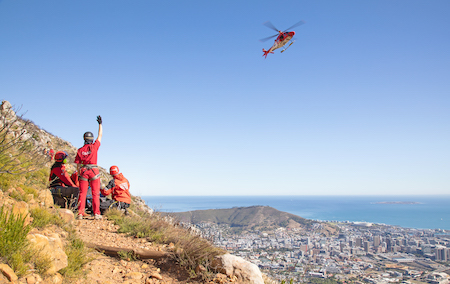
Our Training Begins
I join an AMS rescue training session on Table Mountain, Cape Town. The ELO is Earl Bell, who has been with AMS for a number of years. He rotates between fixed-wing duties and helicopter shifts, with the helicopter being the more dynamic environment. His history includes being a surf lifeguard for Lifesaving South Africa, and he has a strong and calm sense of duty and community that filters across the AMS operation. From my various interactions with AMS pilots, engineers and ELOs over the years, I’ve observed that they all seem to have a balanced and calm personality with measured reactions. This proves extremely useful for high-stress rescue environments. Our training occurs with AMS and various other members of WSAR, to practice inter-agency rescue efforts.
The teams meet at a landing zone (LZ) on Table Mountain, and quickly catch up as we wait for the AMS helicopter to join us from its Cape Town International Airport base. The LZ is secured, ensuring no cyclists, runners or cars are allowed nearby, and radio contact is made with the pilot. The weather is sunny and calm, but the wind is gusting higher on the mountain. The Agusta 119 completes a short observation circle of the LZ and comes into land. The downdraft of the A119 is substantial and any items unsecured near the LZ can be blown away or turned into a potential hazard for the helicopter. With the ground support in position at the LZ, the ELO leans out of the helicopter with one foot on the skids, as he’s super vigilant about hazards on the ground and the clearance of the tail rotor from trees, cars and other obstructions.
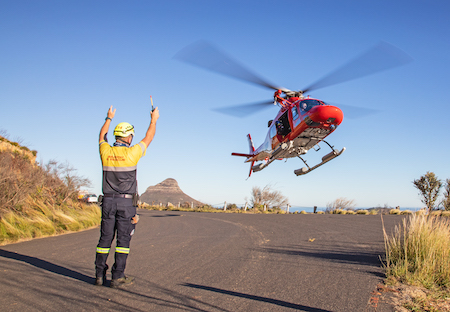
With the landing complete, operations always start with a briefing. I find these briefings (and debriefings) incredibly useful to communicate a clear plan among all role players about the specific goals of the exercise. Any rescue gear that will be utilized, such as stretchers, is discussed with the ELO who goes over: the procedure to unclip from the helicopter and attach to the hoist, the relevant hand signals when you are ready to exit the helicopter and hoist down, where to stand/hold onto when exiting the helicopter, and the signals to give to the helicopter crew once you are unclipped on the ground and ready for the helicopter to depart. The ELO is responsible for the passengers/patients within the helicopter, and the safe operation/serviceability of the hoist.
After the extensive briefing is complete, we start-up. I am part of the first team onboard. In the cabin is Bell, the ELO. Mountain Club of South Africa (MCSA) Search and Rescue’s David Nel is also in the cabin with us. He’ll lead this exercise. It’s my first time hoisting from a helicopter and I’m slightly apprehensive. Nel and Bell both have a reassuring nature, which helps to settle my nerves. We complete final gear checks to ensure all connections are secure, and the helicopter takes off. Shortly afterwards, we are high-up on Table Mountain at our training area. Bell gives the thumbs-up that I can connect to the hoist and thereafter disconnect from the helicopter attachment. With one foot out onto the step and my hand on the handrail, I position and descend to the ground on a 20-meter hoist journey. On reaching the ground I make sure I’m on stable ground with a firm footing before detaching from the hoist and giving the signal to the crew above that they can retract the hoist and move off. A few different stretcher options are practiced, including packaging the “patient.” Eye protection is worn when operating underneath the helicopter because of the amount of dust and objects that get blown by the rotor-blade downwash.
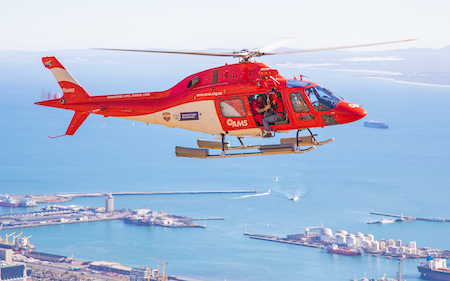
Donovan Kohl is the pilot for the shift. He has extensive South African air force experience and is a qualified aircraft maintenance engineer. He relies heavily on the ELO to operate the hoist safely, while still maintaining safe flight close to the mountain.
Kohl explains that due to the proximity to the mountain and varying heights, their operations fall out of the long-line type, where the pilot would have a clear view of the hoist cable or the short-haul line for the entire process. The communication between the pilot and ELO must be very clear and concise in both directions. It’s essential that unambiguous communication is maintained throughout, with no errors or misunderstandings.
Each crew operating together eventually builds an understanding and an expectation of what each person's operating style is, and a trust in the ELO, who is the eyes of the pilot while conducting rescue operations.
‘’They (ELOs) need to have the ability to paint a clear picture for the pilot as to what they are observing and doing outside the aircraft during these critical moments, such as clearance of the rotors and tail rotor from obstructions. Any unwanted movement by the pilot could place the operation in peril but this is often difficult to avoid due to wind, weather, and micro- climates. All this takes place while the ELO is operating the hoist so they have an extremely difficult and important task to perform,’’ says Kohl.
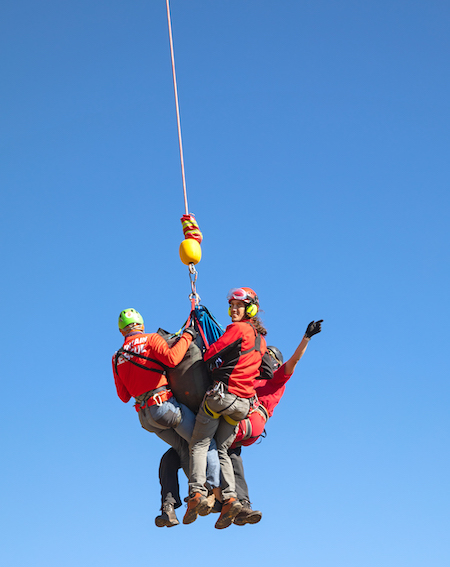
After the exercise is complete, four of us attach to a short-haul line, suspended beneath the helicopter, and are slung off the mountain to the LZ. Landing is tricky but completed successfully using a combination of the signals from the group being suspended, and the ELO communicating to the pilot how to achieve the safe landing of the group swaying beneath the helicopter.
With the flying completed, we stand in a circle to debrief, with each person providing an honest assessment of the exercise: what worked well and what could work better in the future. The expedited learning provided by these briefings is essential, to sharpen rescue skills and to learn from each other.
Teamwork, safety and a collaboration of skills among experts in their respective fields is my overall impression of AMS and their partners. This team will surely grow from strength to strength.
WATCH VIDEO
READ MORE ROTOR PRO NOV/DEC ISSUE
READ MORE ROTOR PRO: https://justhelicopters.com/Magazine
WATCH ROTOR PRO YOUTUBE CHANNEL: https://buff.ly/3Md0T3y
You can also find us on
Instagram - https://www.instagram.com/rotorpro1
Facebook - https://www.facebook.com/rotorpro1
Twitter - https://twitter.com/justhelicopters
LinkedIn - https://www.linkedin.com/company/rotorpro1